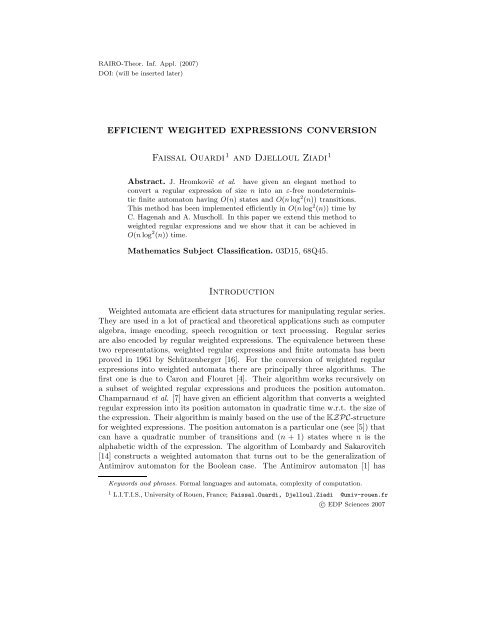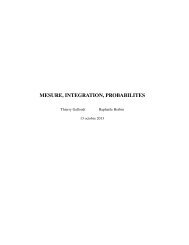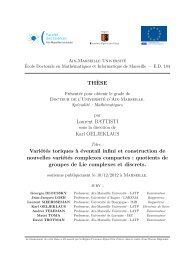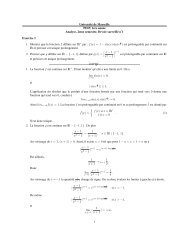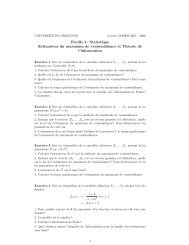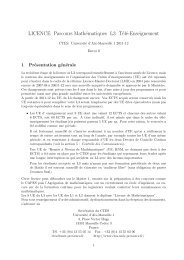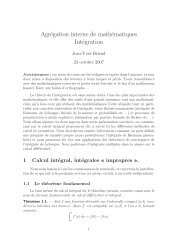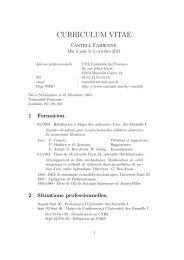Faissal Ouardi and Djelloul Ziadi Introduction - CMI
Faissal Ouardi and Djelloul Ziadi Introduction - CMI
Faissal Ouardi and Djelloul Ziadi Introduction - CMI
Create successful ePaper yourself
Turn your PDF publications into a flip-book with our unique Google optimized e-Paper software.
RAIRO-Theor. Inf. Appl. (2007)<br />
DOI: (will be inserted later)<br />
EFFICIENT WEIGHTED EXPRESSIONS CONVERSION<br />
<strong>Faissal</strong> <strong>Ouardi</strong> 1 <strong>and</strong> <strong>Djelloul</strong> <strong>Ziadi</strong> 1<br />
Abstract. J. Hromkovi˜c et al. have given an elegant method to<br />
convert a regular expression of size n into an ε-free nondeterministic<br />
finite automaton having O(n) states <strong>and</strong> O(n log 2 (n)) transitions.<br />
This method has been implemented efficiently in O(n log 2 (n)) time by<br />
C. Hagenah <strong>and</strong> A. Muscholl. In this paper we extend this method to<br />
weighted regular expressions <strong>and</strong> we show that it can be achieved in<br />
O(n log 2 (n)) time.<br />
Mathematics Subject Classification. 03D15, 68Q45.<br />
<strong>Introduction</strong><br />
Weighted automata are efficient data structures for manipulating regular series.<br />
They are used in a lot of practical <strong>and</strong> theoretical applications such as computer<br />
algebra, image encoding, speech recognition or text processing. Regular series<br />
are also encoded by regular weighted expressions. The equivalence between these<br />
two representations, weighted regular expressions <strong>and</strong> finite automata has been<br />
proved in 1961 by Schützenberger [16]. For the conversion of weighted regular<br />
expressions into weighted automata there are principally three algorithms. The<br />
first one is due to Caron <strong>and</strong> Flouret [4]. Their algorithm works recursively on<br />
a subset of weighted regular expressions <strong>and</strong> produces the position automaton.<br />
Champarnaud et al. [7] have given an efficient algorithm that converts a weighted<br />
regular expression into its position automaton in quadratic time w.r.t. the size of<br />
the expression. Their algorithm is mainly based on the use of the KZPC-structure<br />
for weighted expressions. The position automaton is a particular one (see [5]) that<br />
can have a quadratic number of transitions <strong>and</strong> (n + 1) states where n is the<br />
alphabetic width of the expression. The algorithm of Lombardy <strong>and</strong> Sakarovitch<br />
[14] constructs a weighted automaton that turns out to be the generalization of<br />
Antimirov automaton for the Boolean case. The Antimirov automaton [1] has<br />
Keywords <strong>and</strong> phrases. Formal languages <strong>and</strong> automata, complexity of computation.<br />
1 L.I.T.I.S., University of Rouen, France; <strong>Faissal</strong>.<strong>Ouardi</strong>, <strong>Djelloul</strong>.<strong>Ziadi</strong> @univ-rouen.fr<br />
c○ EDP Sciences 2007
2 F. OUARDI AND D. ZIADI<br />
less states than the position automaton. As the position automaton, Antimirov<br />
automaton can have a quadratic number of transitions.<br />
In the Boolean case many algorithms have been developed for the problem<br />
of conversion [2, 8, 12, 15, 19]. The best one in term of complexity is that proposed<br />
by Hromkovi˜c et al. [11] <strong>and</strong> implemented by Hagenah <strong>and</strong> Muscholl [9].<br />
This automaton called the common follow sets automaton has O(n) states <strong>and</strong><br />
O(n log 2 (n)) transitions. Hagenah <strong>and</strong> Muscholl proved that this automaton can<br />
be constructed from a regular expression of size n in time O(n log 2 (n)) which<br />
constitutes the best known algorithm for the conversion problem.<br />
In this paper, we extend the algorithm of Hromkovi˜c et al. to weighted regular<br />
expressions <strong>and</strong> we present an efficient algorithm to convert a weighted regular<br />
expression of size n into an automaton having O(n) states <strong>and</strong> O(n log 2 (n)) in<br />
O(n log 2 (n)) time.<br />
In Section 1 we recall the notion of a K-expression <strong>and</strong> of a formal series. In Section<br />
2 we present the position automaton construction. In Section 3 we introduce<br />
the notion of common follow polynomials automaton which is the generalization of<br />
the notion of common follow sets automaton presented in [11]. In Section 4 we recall<br />
the KZPC-structure in order to implement efficiently the algorithm introduced<br />
in Section 5. Finally in Section 6 <strong>and</strong> 7 we describe our algorithm.<br />
1. Preliminaries<br />
Let A be a finite alphabet, <strong>and</strong> (K, ⊕, ⊗, 0, 1) be a semiring (commutative or<br />
not). The operator star � can be partially defined, the scalar y = x � ∈ K being a<br />
solution (if there exists) of the equations y⊗x⊕1 =y <strong>and</strong> x⊗y⊕1 =y with 0 � =1<br />
[10, 13]. In this paper, we will give examples using the semiring (Q, ⊕, ⊗) with<br />
the classical definitions for ⊕ (addition) <strong>and</strong> ⊗ (multiplication). In the following<br />
definition, we introduce the notion of K-expression.<br />
Definition 1.1. K-expressions over an alphabet A are inductively defined as<br />
follows:<br />
• a ∈ A <strong>and</strong> k ∈ K are K-expressions;<br />
• if F <strong>and</strong> G are K-expressions, then (F + G), (F · G), <strong>and</strong> (F ∗ ) are Kexpressions.<br />
When there is no ambiguity, the K-expression (F · G) will be denoted (F G). Let<br />
EbeaK-expression. We will denote AE the alphabet of E. The linearized version<br />
EofEistheK-expression deduced from E by ranking every letter occurrence with<br />
its position in E. Subscripted letters are called positions. The size of E, denoted<br />
| E | is the size of the syntax tree of E. For example, if E = ( 1<br />
2 · a∗ + 1<br />
3 · b∗ ) ∗ · a ∗ ,<br />
we get AE = {a, b}, E=( 1<br />
2 · a∗ 1<br />
+ 1<br />
3 · b∗ 2 )∗ · a ∗ 3 , A E = {a1,b2,a3} <strong>and</strong> |E| = 13.
EFFICIENT WEIGHTED EXPRESSIONS CONVERSION 3<br />
We define inductively the null term of a K-expression E, denoted c(E), by:<br />
c(k) = k for all k ∈ K,<br />
c(a) = 0 for all a ∈ A,<br />
c(F + G) = c(F) ⊕ c(G),<br />
c(F G) = c(F) ⊗ c(G),<br />
c(F ∗ ) = c(F) � .<br />
The null term of E = ( 1<br />
2a∗ + 1<br />
3b∗ ) ∗a∗ is c(E) = 6.<br />
In the following, we present a brief description of formal series <strong>and</strong> we define a<br />
subset of the set of K-expressions, usually called regular K-expressions, which are<br />
associated to regular series [3].<br />
Definition 1.2. A (non-commutative) formal series with coefficients in K <strong>and</strong><br />
variables in A is a map from the free monoid A ∗ to K that associates with the<br />
word w ∈ A ∗ acoefficient〈S, w〉 ∈K.<br />
A formal series is usually written as an infinite sum: S = �<br />
u∈A∗〈S, u〉u.<br />
The support of the formal series S is the language supp(S) ={u ∈ A∗ |〈S, u〉 �= 0}.<br />
The set of formal series over A with coefficients in K is denoted by K〈〈A〉〉.<br />
A structure of semiring is defined on K〈〈A〉〉 as follows [3, 13]:<br />
– 〈S + T,u〉 = 〈S, u〉⊕〈T,u〉;<br />
– 〈ST,u〉 = �<br />
〈S, u1〉⊗〈T,u2〉, withS, T ∈ K〈〈A〉〉.<br />
u1u2=u<br />
A polynomial is a formal series with finite support. The set of polynomials is<br />
denoted by K〈A〉. It is a subsemiring of K〈〈A〉〉. The star of series is defined by:<br />
S ∗ = �<br />
n≥0 Sn with S 0 = ε, S n = S n−1 S if n>0. Notice that the star of a<br />
formal series does not always exist.<br />
Proposition 1.3 (cf. [13]). The star of a formal series S ∈ K〈〈A〉〉 is defined if<br />
<strong>and</strong> only if 〈S, ε〉 � is defined in K. In this case:<br />
S ∗ = 〈S, ε〉 � (Sp〈S, ε〉 � ) ∗<br />
where the formal series Sp is defined by 〈Sp,ε〉 =0<strong>and</strong> 〈Sp,u〉 = 〈S, u〉 for any<br />
word u.<br />
In the following, we will consider the previous construction of the star of formal<br />
series.<br />
Definition 1.4. The semiring of regular series KRat(A ∗ ) ⊂ K〈〈A〉〉 is the smallest<br />
set of K〈〈A〉〉 that contains the polynomials semiring K〈A〉, <strong>and</strong> that is stable by<br />
the operations of addition, product <strong>and</strong> star when this latter is defined.<br />
The following definition introduces the notion of regular K-expression.<br />
(1)
4 F. OUARDI AND D. ZIADI<br />
Definition 1.5. AregularK-expression is defined inductively by:<br />
– a ∈ A, k ∈ K are regular K-expressions that respectively denote the regular<br />
series Sa = a <strong>and</strong> Sk = k;<br />
– if F, G <strong>and</strong> H (such that c(H) � exists) are regular K-expressions that<br />
respectively denote the regular series SF, SG <strong>and</strong> SH, then(F+G), (F G),<br />
<strong>and</strong> (H ∗ ) are regular K-expressions that respectively denote the regular<br />
series SF + SG, SFSG <strong>and</strong> SH ∗ .<br />
The set of regular K-expressions over an alphabet A is denoted by K Exp(A).<br />
Definition 1.6. Let A be a finite alphabet, <strong>and</strong> K be a semiring (commutative or<br />
not). We define an automaton with multiplicities A = 〈Q, A, q0,δ,γ,μ〉 as follows:<br />
• Q is a finite set of states;<br />
• q0 is the initial state;<br />
• δ ⊆ Q × A × Q is the set of transitions;<br />
• γ : δ → K is the transition weight function;<br />
• μ : Q → K is the output weight function.<br />
The definition of an automaton with multiplicities is more general but this one<br />
is sufficient for our construction.<br />
Apathp from a state q to a state q ′ is a sequence of transitions (q, a1,q1),<br />
(q1,a2,q2), ··· , (qn−1,an,qn = q ′ )inA. It is written p =(p1,p2, ··· ,pn) with<br />
pi =(qi−1,ai,qi) for1≤ i ≤ n. Its label is the word w(p) =a1a2 ···an. We<br />
denote by coef(p) the cost of the path p in A. Formally, coef(p) =γ(p1) ⊗ γ(p2) ⊗<br />
···⊗γ(pn) ⊗ μ(qn).<br />
Let CA the set of all paths in A starting at q0. The series SA associated with<br />
the automaton A is<br />
where:<br />
SA = �<br />
〈SA,u〉u<br />
u∈A ∗<br />
〈SA,u〉 = �<br />
p∈C A<br />
w(p)=u<br />
coef(p).<br />
We say that the automaton A realizes the series SA.<br />
Definition 1.7. AformalseriesS ∈ K〈〈A〉〉 is called recognizable if there exists<br />
an automaton that realizes it.<br />
The following result due to Schützenberger [16] is classical.<br />
Theorem 1.8. (Schützenberger, 1961). A formal series is recognizable if <strong>and</strong> only<br />
if it is regular.<br />
Let S be a series in K〈〈A〉〉. Ifh : A −→ B is a surjective morphism, then h(S)<br />
denotes the series �<br />
〈S, u〉h(u) inK〈〈A〉〉.<br />
u∈A ∗
EFFICIENT WEIGHTED EXPRESSIONS CONVERSION 5<br />
Proposition 1.9. Let A = 〈Q, X, q0,δ,γ,μ〉 <strong>and</strong> B = 〈Q, Y, q0,δ ′ ,γ ′ ,μ〉 be two<br />
automata. Let h: X → Y be a surjective morphism where<br />
(1) (p, a, q) ∈ δ ′ ⇔ There exists (p, ai,q) ∈ δ such that h(ai) =a,<br />
(2) γ ′ (p, a, q) =<br />
�<br />
γ(p, ai,q).<br />
We have, SB = h(SA).<br />
h(a i )=a<br />
(p,ai,q)∈δ<br />
Proof. Let ΩA be the set of sequences in A,<br />
ΩA = {(q0,q1), (q1,q2), ··· , (qn−1,qn)|∃aki ∈ X,<br />
s.t. (qi−1,aki,qi) ∈ δ, ∀1 ≤ i ≤ n}. (2)<br />
We define the transitions polynomial between two states q <strong>and</strong> q ′ as<br />
ΔA(q, q ′ )= �<br />
(q,a,q ′ )∈δ<br />
γ(q, a, q ′ )a.<br />
For a sequence ρ =((q0,q1), (q1,q2), ··· , (qn−1,qn)) in ΩA, weset<br />
ΔA(ρ) =<br />
n�<br />
ΔA(qi−1,qi)μ(qn).<br />
i=1<br />
Thus, the series SA associated with the automaton A can be written as<br />
SA = �<br />
ρ∈ΩA<br />
Now let us prove that h(SA) =SB. Wehave<br />
⎛<br />
h(SA) = h ⎝ �<br />
⎞<br />
ΔA(ρ) ⎠<br />
⎛<br />
= h ⎝<br />
= �<br />
ρ∈ΩA<br />
�<br />
ΔA(ρ).<br />
ρ=((q0,q1),(q1,q2),··· ,(qn−1,qn))∈ΩA<br />
⎡<br />
n�<br />
⎣<br />
ρ∈ΩA i=1<br />
�<br />
(qi−1,ai,qi)∈δ<br />
� n�<br />
i=1<br />
ΔA(qi−1,qi)<br />
⎤<br />
γ(qi−1,ai,qi)h(ai)μ(qn) ⎦<br />
�⎞ ⎠ μ(qn)
6 F. OUARDI AND D. ZIADI<br />
Condition (1)<br />
=<br />
Condition (2)<br />
=<br />
=<br />
Condition (1),Relation 2<br />
=<br />
�<br />
n�<br />
�<br />
ρ∈ΩA i=1 (qi−1,a,qi)∈δ ′<br />
�<br />
n�<br />
�<br />
ρ∈ΩA i=1 (qi−1,a,qi)∈δ ′<br />
�<br />
ρ∈ΩA<br />
�<br />
ρ∈ΩB<br />
ΔB(ρ)<br />
ΔB(ρ)<br />
⎡⎛<br />
⎢⎜<br />
⎢⎜<br />
⎢⎜<br />
⎣⎝<br />
�<br />
(q i−1 ,a ki ,q i )∈δ<br />
h(ak i )=a<br />
γ(qi−1,aki,qi)<br />
[γ ′ (qi−1,a,qi)aμ(qn)]<br />
⎞<br />
⎟<br />
⎠ aμ(qn)<br />
⎤<br />
⎥<br />
⎦<br />
= SB. �<br />
2. Position automaton<br />
In this section, we recall some basic notions related to the construction of position<br />
automata from regular K-expressions. Let E be a regular K-expression over<br />
an alphabet A. The position automaton associated with E is computed from three<br />
functions First(E), Last(E) <strong>and</strong> Follow(·, E) in K Exp(A) −→ K〈A〉. Theycanbe<br />
computed inductively according to the following rules [7]:<br />
First(k) = 0 for all k ∈ K, (3)<br />
First(a) = 1ai (ai is the position associated to a in AE ) , (4)<br />
First(F + G) = First(F) + First(G), (5)<br />
First(F G) = First(F) + c(F) First(G), (6)<br />
First(F ∗ ) = c(F) � First(F). (7)<br />
We obtain the same rule for Last by substituting Last for First <strong>and</strong> replacing the<br />
formula (6) by:<br />
Last(F G) = Last(G) + c(G) Last(F). (8)<br />
Given a position x ∈ A E , the function Follow(x, E) is inductively computed as<br />
follows:<br />
Follow(x, k) = 0 for all k ∈ K,<br />
Follow(x, a) = 0 for all a ∈ A,<br />
Follow(x, F + G) = Follow(x, F) + Follow(x, G),<br />
Follow(x, F G) = Follow(x, F) + 〈Last(F),x〉 First(G) + Follow(x, G),<br />
Follow(x, F ∗ ) = Follow(x, F) + 〈Last(F ∗ ),x〉 First(F).
EFFICIENT WEIGHTED EXPRESSIONS CONVERSION 7<br />
Let h be the mapping from A E to AE induced by the linearization of E over A E .<br />
It maps every position to its value in AE. For example, if E=2a1 +3b2 + a3<br />
then h(a1) =h(a3) =a <strong>and</strong> h(b2) =b. The First, Last <strong>and</strong> Follow polynomials of<br />
aregularK-expression E can be used to define an automaton with multiplicities<br />
realizing SE. We define the position automaton for E, denoted AE, as the 6-tuple<br />
〈Q, AE,q0,δ,γ,μ〉 where, for some q0 /∈ A E :<br />
• Q = {q0}∪A E .<br />
• (q, a, p) ∈ δ ⇔ h(p) =a <strong>and</strong> if q = q0 then 〈First(E),p〉 �= 0,else<br />
〈Follow(q, E),p〉 �= 0.<br />
• For all (p, a, � q) ∈ δ, one has:<br />
〈First(E),p〉 if q = q0,<br />
γ(q, a, p) =<br />
�<br />
〈Follow(q, E),p〉 otherwise.<br />
c(E) if q = q0,<br />
• μ(q) =<br />
〈Last(E),q〉 otherwise.<br />
Proposition 2.1. [7] Let E be a regular K-expression <strong>and</strong> AE its position automaton.<br />
Then AE realizes the regular series SE.<br />
Lemma 2.2. Let E be a regular K-expression <strong>and</strong> E its linearized version. Then<br />
one has SE = h(SE).<br />
Proof. Let AE be the position automaton associated with E <strong>and</strong> A E be the position<br />
automaton associated with E. The surjective morphism h from A E into AE satisfies<br />
the conditions (1) <strong>and</strong> (2) of Proposition 1.9. Then, one has:<br />
SAE = h(SA E ).<br />
From Proposition 2.1, we have SAE = SE <strong>and</strong> SA E = S E .ThusSE = h(S E ). �<br />
3. Common follow polynomials automaton<br />
In this section, we introduce the notion of common follow polynomials system<br />
which is the generalization of the notion of the common follow sets introduced by<br />
Hromkovi˜c et al. [11] in order to compute an automaton having less transitions<br />
than the position automaton.<br />
Next, we prove that the CFP automaton induced by the common follow polynomials<br />
system realizes the same series as the position automaton.<br />
Finally, we recall the KZPC-structure in order to implement an efficient algorithm<br />
to convert a regular K-expression into its CFP automaton.<br />
From now, we will consider the expression E ′ =(E · ♯) with♯/∈ A E .<br />
Definition 3.1. Let E be a regular K-expression <strong>and</strong> let x be a position in A E .<br />
The set dec(x) ={(k1,P1), ··· , (km,Pm)} where {P1, ···Pm} is a set of polynomials<br />
with pairwise disjoints supports <strong>and</strong> {k1, ··· ,km} m elements of K, is called<br />
follow decomposition of x if <strong>and</strong> only if one has:<br />
Follow(x, E) = k1P1 + k2P2 + ···+ kmPm.
8 F. OUARDI AND D. ZIADI<br />
Proposition 3.2. Let x be a position in A E , <strong>and</strong> let dec(x) = {(k1,P1), ··· ,<br />
(km,Pm)} <strong>and</strong> dec ′ (x) ={(k ′ 1 ,P1), ··· , (k ′ m ,Pm)} be two follow decompositions<br />
of x. Then, one has ki = k ′ i , for all 1 ≤ i ≤ m.<br />
Proof. It comes from the fact that supp(Pi) ∩ supp(Pj) =∅, for all 1 ≤ i, j ≤ m<br />
<strong>and</strong> i �= j. �<br />
We will write kPi x the coefficient of Pi in the follow decomposition of x <strong>and</strong><br />
Pr(dec(x)) the set {P1, ··· ,Pm}.<br />
Definition 3.3 (common follow polynomials system). Let E be a regular Kexpression<br />
<strong>and</strong> E ′ = E♯. A common follow polynomials system S(E) =<br />
(dec(x))x∈A of E is a family of follow decompositions of positions in A E E . FS(E) =<br />
{First(E ′ )}∪ �<br />
Pr(dec(x)) is called the set of common follow polynomials asso-<br />
x∈A E<br />
ciated with the system S(E).<br />
Notice that the common follow polynomial system S(E)isnotuniqueaswecan<br />
see in the following example.<br />
Example 3.4. Let E = ( 1 1 1<br />
3a + 6b)( 2a∗b). One has:<br />
E ′ = ( 1<br />
3 a1 + 1 1<br />
b2)(<br />
6 2 a∗3b4)♯, First(E ′ ) = 1<br />
3 a1 + 1<br />
6 b2,<br />
Follow(a1, E ′ ) = 1<br />
2 a3 + 1<br />
2 b4,<br />
Follow(b2, E ′ ) = 1<br />
2 a3 + 1<br />
2 b4,<br />
Follow(a3, E ′ ) = a3 + b4,<br />
Follow(b4, E ′ ) = ♯.<br />
S(E) = { S ′ (E) = {<br />
dec(a1) ={( 1<br />
2 , (a3 + b4))}, dec(a1) ={( 1<br />
2 ,a3), ( 1<br />
2 ,b4)},<br />
dec(b2) ={( 1<br />
2 , (a3 + b4))}, dec(b2) ={( 1<br />
2 ,a3), ( 1<br />
2 ,b4)},<br />
dec(a3) ={(1, (a3 + b4))}, dec(a3) ={(1, (a3 + b4))},<br />
dec(b4) ={(1,♯)} dec(b4) ={(1,♯)}<br />
} }<br />
FS(E) = { 1<br />
3a1 + 1<br />
6b2,a3 + b4,♯} FS ′ (E) = { 1<br />
3a1 + 1<br />
6b2,a3,b4,a3 + b4,♯}<br />
Definition 3.5 (CFP automaton). Let E a regular K-expression. Let S(E) be<br />
a common follow polynomials system of E. The common follow polynomials automaton<br />
A S(E) = 〈Q, AE,q0,δ1,γ1,μ〉 associated with S(E) is defined by:<br />
• Q = F S(E),<br />
• q0 = {First(E ′ )},<br />
• (P, a, P ′ ) ∈ δ1 ⇔ There exists ai ∈ A E such that the following holds:
EFFICIENT WEIGHTED EXPRESSIONS CONVERSION 9<br />
– h(ai) =a,<br />
– 〈P, ai〉 �= 0,<br />
– P ′ ∈ Pr(dec(ai)).<br />
• For all (P, a, P ′ ) ∈ δ1, one has: γ1(P, a, P ′ )= �<br />
• μ(P )=〈P, ♯〉.<br />
a i ∈A E<br />
h(ai)=a<br />
′<br />
P<br />
〈P, ai〉⊗kai .<br />
Theorem 3.6. Let E be a regular K-expression <strong>and</strong> A S(E) the common follow<br />
polynomials automaton associated with a CFP system S(E). Then A S(E) realizes<br />
the regular series SE.<br />
To prove this theorem, we introduce the automaton AS(E) = 〈Q, AE ,q0,δ2,γ2,μ〉<br />
defined as follows:<br />
• Q = FS(E). • q0 = {First(E ′ )}.<br />
• (P, ai,P ′ ) ∈ δ2 ⇔ The following holds:<br />
– 〈P, ai〉 �= 0,<br />
– P ′ ∈ Pr(dec(ai)).<br />
• For all (P, ai,P ′ ) ∈ δ2, one has: γ2(P, ai,P ′ ′<br />
P )=〈P, ai〉⊗k<br />
• μ(P )=〈P, ♯〉.<br />
Lemma 3.7. Let E be a regular K-expression. The automaton A S(E) realizes the<br />
series S E .<br />
Proof. Let E be a regular K-expression <strong>and</strong> A E the position automaton associated<br />
to its linearized version E<strong>and</strong>letS(E) = (dec(x))x∈A E a CFP system associated<br />
with E. Let w = a1a2 ···an ∈ A ∗<br />
E , From Proposition 2.1, A E realizes the series S E ,<br />
so to prove this lemma it suffices to show that for each path p ∈CA E , such that<br />
m(p) =w, there exists a unique equivalent path p ′ ∈CA S(E) such that m(p ′ )=w<br />
<strong>and</strong> coef(p) = coef(p ′ ), <strong>and</strong> conversely.<br />
Let p = (q0,a1,q1), ··· , (qn−1,an,qn) beapathinCA E . Accordingtothe<br />
definition of the automaton A E , one has:<br />
〈First(E),a1〉 �= 0, (9)<br />
〈Follow(ai, E),ai+1〉 �= 0, ∀1 ≤ i ≤ n − 1. (10)<br />
Let Pi the unique polynomial in Pr(dec(ai)) such that 〈Pi,ai+1〉 �= 0i.e. ai+1 ∈<br />
supp(Pi) <strong>and</strong>Pi ∩Pj = ∅ ∀1 ≤ i �= j ≤ n. Pi exists since 〈Follow(ai, E),ai+1〉 �= 0.<br />
So the path<br />
p ′ = (First(E),a1,P1), (P1,a2,P2), ··· , (Pn−1,an,Pn) (11)<br />
exists in A S(E) <strong>and</strong> is unique.<br />
ai .
10 F. OUARDI AND D. ZIADI<br />
Let us prove that coef(p) = coef(p ′ ). One has:<br />
coef(p) = γ(q0,a1,q1) ⊗ γ(p1,a2,q2) ···γ(qn−1,an,qn) ⊗ μ(qn),<br />
Def. of A E<br />
= 〈First(E),a1〉⊗〈Follow(a1,E),a2〉···〈Follow(an−1,E),an〉<br />
⊗〈Last(E),an〉;<br />
<strong>and</strong><br />
coef(p ′ ) = γ2(First(E),a1,P1) ⊗ γ2(P1,a2,P2) ⊗···⊗<br />
γ2(Pn−1,an,Pn) ⊗ μ(Pn),<br />
Def. of A S(E)<br />
= 〈First(E),a1〉⊗k P1<br />
a1<br />
⊗k Pn−1<br />
an<br />
⊗ μ(pn).<br />
⊗〈P1,a2〉⊗k P2<br />
a2 ···〈Pn−1,an〉<br />
From Definition 3.1, We have Follow(ai, E) = k Pi 1<br />
ai Pi1 + ···+ k Pi<br />
ai Pi + ···+ k Pin<br />
ai Pin.<br />
Then, one has<br />
k Pi<br />
ai ⊗〈Pi,ai+1〉 = 〈Follow(ai, E),ai+1〉, for all 1 ≤ i ≤ n − 1<strong>and</strong>〈Last(E),an〉 =<br />
μ(Pn). �<br />
Proof of Theorem 3.6. Let E be a regular K-expression. Let h be the surjective<br />
morphism from A E into AE. We consider the automata A S(E) <strong>and</strong> A S(E), the<br />
application h satisfies the conditions (1) <strong>and</strong> (2) of Proposition 1.9, then one has:<br />
SA S(E) = h(SA S(E) ),<br />
Lemma 3.7<br />
= h(S E ),<br />
Lemma 2.2<br />
= SE. �<br />
Example 3.8. Consider the regular K-expression E = ( 1<br />
3<br />
linearized version of E is E=( 1<br />
3 a1 + 1<br />
6b2 + 1<br />
2<br />
a + 1<br />
6<br />
1 1 b + 2a)( 2a∗b). The<br />
a3)( 1<br />
2 a∗ 4b5). Consider the following<br />
set of common follow polynomials F S(E) = { 1<br />
3 a1 + 1<br />
6 b2 + 1<br />
2 a3}∪{a4 + b5,♯}.<br />
Note that for the previous example, the position automaton associated with E<br />
has 6 states <strong>and</strong> 11 transitions (see Fig. 1). However there exists a CFP automaton<br />
realizing the series SE with only 3 states <strong>and</strong> 4 transitions (see Fig. 2).<br />
The number of transitions <strong>and</strong> the number of states in a common follow polynomials<br />
automaton obviously depends on the choice of the common follow polynomials<br />
system. The next section deals with the problem of finding appropriate<br />
common follow polynomials system.<br />
A good choice can be found by resolving the following system:<br />
� �<br />
Minimize(f(E) = nxmx)<br />
x∈A E<br />
where mx denotes the number of polynomials C ∈F S(E) such that 〈C, x〉 �= 0<strong>and</strong><br />
nx denotes the size of dec(x).
EFFICIENT WEIGHTED EXPRESSIONS CONVERSION 11<br />
1<br />
q0<br />
1<br />
3 a1<br />
1<br />
6 b2<br />
1<br />
2 a3<br />
a1<br />
a3<br />
b2<br />
1<br />
2 a4<br />
1<br />
2 a4<br />
1<br />
2 b5<br />
1<br />
2 b5<br />
1<br />
2 b5<br />
1<br />
2 a4<br />
Figure 1. The position automaton for E=( 1<br />
3 a1 + 1<br />
1<br />
1<br />
3 a1 + 1<br />
6 b2 + 1<br />
2 a3<br />
a4<br />
b5<br />
1 1 1<br />
6 a1, 12 b2, 4<br />
a4 + b5<br />
a3 b5<br />
Figure 2. A CFP automaton for E=( 1<br />
3 a1 + 1<br />
1<br />
1<br />
3<br />
1 1<br />
a1 + 6<br />
b2 + 2 a3<br />
5 1<br />
12 a,<br />
a4<br />
12 b b<br />
a4 + b5<br />
Figure 3. A CFP automaton for E = ( 1<br />
3<br />
a<br />
b4<br />
1<br />
6b2 + 1<br />
2<br />
6b2 + 1<br />
2<br />
a + 1<br />
6<br />
a3)( 1<br />
2 a∗ 4 b5).<br />
1<br />
a3)( 1<br />
2 a∗ 4 b5).<br />
1<br />
1 1 b + 2a)( 2a∗b). From the definition of the automaton A S(E) , the function f represents the<br />
number of its transitions.<br />
Unfortunately, in the practice this method is not efficient. In the Boolean case<br />
J. Hromkovi˜c et al. [11], presented an elegant method that computes a particular<br />
common follow sets system which yields to a common follow sets automaton<br />
having O(n) states <strong>and</strong> O(n log 2 (n)) transitions where n denote the size of the<br />
regular expression. In [9] C. Hagenah <strong>and</strong> A. Muscholl have shown that this particular<br />
automaton can be computed in time O(n log 2 (n)) which is the best known<br />
algorithm for the problem of conversion in the boolean case.<br />
In the next sections, we prove that for a regular K-expression of size n there<br />
exists a common follow polynomials automaton with O(n log 2 (n)) transitions <strong>and</strong><br />
O(n) states. This constitutes the generalization of the result proved by<br />
J. Hromkovi˜c et al. [11]. Next we give an efficient algorithm that computes<br />
this automaton in time O(n log 2 (n)).<br />
Our algorithm is based on the KZPC-structure . This structure has been introduced<br />
in [7], in order to compute the position automaton. Its boolean version<br />
is described in [17, 19]. The following section gives a brief description of this<br />
structure.
12 F. OUARDI AND D. ZIADI<br />
4. KZPC-structure<br />
Let E be a regular K-expression. The KZPC-structure of E is based on two<br />
labeled trees (TL(E) <strong>and</strong> TF(E)) deduced from its syntax tree T(E). These trees<br />
encode respectively the Last <strong>and</strong> the First polynomials associated to the subexpressions<br />
of E. The edges of these trees are labeled by elements of the semiring<br />
K.<br />
AnodeinT(E) will be noted ν. If the arity of ν is two, we write respectively<br />
νl <strong>and</strong> νr its left son <strong>and</strong> its right son. If its arity is 1, its son will be noted νs.<br />
The relation of descendance over the syntax tree is denoted �. Let (ν1,ν2) an<br />
edge in TL(E) (or in TF(E)), we denote by α(ν1,ν2) its label. For a tree whose<br />
edges are labeled by elements of the semiring K, we define the cost of the path<br />
(ν = ν1,ν2, ··· ,νk = ν ′ ), written π(ν, ν ′ ), as<br />
�<br />
k−1<br />
α(νi,νi+1).<br />
i=1<br />
By convention we set π(ν, ν) =1.<br />
A subtree t of T(E) is a tree associated to a subexpression of E, or a tree<br />
obtained from T(E) by deleting a set of trees which represent some subexpressions<br />
of E. This definition is also applied to t. Let t1 beasubtreeoft,wedenotebyt\ t1<br />
the subtree of t resulting from t by deleting the subtree t1. WedenotebyPos(t)<br />
the set of positions of A E in t. As a measure of t we use the cardinality of the<br />
nodes set of t. It denoted by | t |. Foranodeν in T(E), the regular K-expression<br />
Eν denotes the subexpression resulting from the node ν <strong>and</strong> c(ν) its null term.<br />
The Last tree TL(E) is a labeled copy of T(E), where an edge going from a node λ<br />
labeled “·” toitsleftsonλl is marked by α(λl,λ)=c(λl) <strong>and</strong> for each edge going<br />
from a node λ labeled “∗” toitssonλs is marked by α(λs,λ)=c(λs) � . For all<br />
other edges (λ, λ ′ ), we set α(λ, λ ′ )=1. Thenodeλ represents the polynomial<br />
Thus we have<br />
e(λ) = �<br />
x∈A E<br />
e(λ) = Last(Eλ).<br />
π(x, λ)x. (12)<br />
The First tree TF(E) is computed in a similar way, by marking an edge going from<br />
anodeϕ labeled “·” to its right son ϕr by α(ϕ, ϕr) =c(ϕl) <strong>and</strong> a edge going from<br />
anodeϕ to its son ϕs is marked by α(ϕs,ϕ)=c(ϕs) � . For all other edges (ϕ, ϕ ′ ),<br />
we set α(ϕ, ϕ ′ )=1. Thenodeϕ represents the polynomial<br />
e(ϕ) = �<br />
π(ϕ, x)x. (13)<br />
x∈A E
Thus we have<br />
EFFICIENT WEIGHTED EXPRESSIONS CONVERSION 13<br />
1<br />
3<br />
1<br />
4<br />
TL( E )<br />
∗<br />
+<br />
• •<br />
• • 1<br />
2<br />
a1<br />
1<br />
4<br />
2<br />
1<br />
∗<br />
b2<br />
1<br />
∗<br />
b3<br />
,ELside=r<br />
1<br />
3<br />
TF( E )<br />
∗<br />
+<br />
• •<br />
• • 1<br />
2<br />
Figure 4. The KZPC-structure associated to the expression<br />
E=( 1 1<br />
3a 4b∗ + 1<br />
2b∗ ) ∗ .<br />
1<br />
3<br />
a1<br />
e(ϕ) = First(Eϕ).<br />
The two trees are connected as follows: if a node λ of TL(E) is labeled by “·”, its<br />
left son λl is linked to the right son ϕr of the corresponding node ϕ in TF(E). If<br />
a node in TL(E) labeled “∗” its son node is linked to its corresponding node in<br />
TF(E). Such links are called follow links. The set of follow links is denoted by<br />
Δ. We denote by Δx the set of follow links associated to the position x. Thatis:<br />
Δx = {(λ, ϕ) ∈ Δ | x � λ}.<br />
Proposition 4.1. Let E be a regular K-expression <strong>and</strong> x ∈ AE .Then<br />
Follow(x, E) = �<br />
π(x, λ)e(ϕ). (14)<br />
(λ,ϕ)∈Δx<br />
5. A CFP system computation<br />
Now we describe a procedure which allows us to produce a CFP system that<br />
yields to a CFP automaton with O(n log 2 (n)) transitions <strong>and</strong> O(n) states. This<br />
procedure is a generalization of J. Hromkovi˜c et al. one.<br />
1<br />
4<br />
0<br />
1<br />
4<br />
∗<br />
b2<br />
2<br />
1<br />
1<br />
2<br />
∗<br />
b3<br />
1
14 F. OUARDI AND D. ZIADI<br />
We introduce the function f :TL(E ′ ) → TF(E ′ ) ∪{⊥}defined by:<br />
f(λ) =<br />
� ϕ if (λ, ϕ) ∈ Δx,<br />
⊥ otherwise,<br />
where ⊥ denotes an artificial node such that π(x, ⊥) =0.<br />
We extend the polynomial Follow to the nodes of the tree TL(E ′ )<strong>and</strong>TF(E ′ )as<br />
follows:<br />
if λ1 <strong>and</strong> λ2 are two nodes in TL(E ′ ) such that λ1 � λ2, then<br />
Follow(λ1,λ2) = �<br />
λ 1 �λ≺λ 2<br />
f(λ)=ϕ<br />
π(λ1,λ)e(ϕ), (15)<br />
<strong>and</strong> if ϕ1 <strong>and</strong> ϕ2 are two nodes in TF(E ′ ) such that ϕ1 � ϕ2, then<br />
Follow(ϕ1,ϕ2) = �<br />
π(ϕ1,ϕ)e(λ). (16)<br />
ϕ 1 �ϕ≺ϕ 2<br />
f(λ)=ϕ<br />
Let P be a polynomial <strong>and</strong> let t be a subtree of T(E ′ ). The restriction of P to t,<br />
denoted by Pt is the polynomial<br />
Pt = �<br />
〈P, x〉x.<br />
x∈Pos(t)<br />
LettbeasubtreeofT(E ′ )<strong>and</strong>x a position in Pos(t) \{♯}. We denote by tf<br />
(respectively tl) the labeled copy of t in TF(E ′ ) (respectively in TL(E ′ )). The<br />
procedure recursively computes a particular CFP system. It is defined as follows.<br />
If | Pos(t)| > 1<br />
Decompose t into two subtrees t1 <strong>and</strong> t2 according to the following rules:<br />
| Pos(t)|<br />
2| Pos(t)|<br />
3 ≤|Pos(t1)| ≤ 3<br />
tl1 <strong>and</strong> ϕ1 its corresponding node in tf1. Let<br />
We have for all x ∈ Pos(t):<br />
<strong>and</strong> let t2 =t\ t1 with λ1 be the root of the subtree<br />
P1 = Followt2 (λ1, E ′ ),<br />
P2 = e(ϕ1),<br />
P3 = e(λ1),<br />
P4 = Follow(ϕ1, E ′ ).<br />
Followt(x, E ′ ) = Followt1(x, E ′ ) + Followt2(x, E ′ ).
Case x ∈ Pos(t1):<br />
One has<br />
Thus<br />
Followt2(x, E ′ )<br />
EFFICIENT WEIGHTED EXPRESSIONS CONVERSION 15<br />
Relation (15)<br />
=<br />
=<br />
�<br />
x�λ≺E ′<br />
f(λ)=ϕ<br />
�<br />
x�λ≺E ′<br />
f(λ)=ϕ<br />
π(x, λ)et2(ϕ)<br />
= π(x, λ1) �<br />
π(x, λ1) ⊗ π(λ1,λ)et2(ϕ)<br />
λ 1 �λ≺E ′<br />
f(λ)=ϕ<br />
Relations (12) <strong>and</strong> (15)<br />
= 〈e(λ1),x〉P1<br />
= k P1<br />
x P1.<br />
Followt(x, E ′ ) = Followt1(x, E ′ )+k P1<br />
x P1.<br />
π(λ1,λ)et2(ϕ)<br />
It is easy to see that supp(Followt1(x, E ′ )) ∩ supp(P1) =∅. If k P1<br />
x �=0,(kP1<br />
x ,P1)<br />
constitues the first element of our follow decomposition dec(x, t) ofx in t. We<br />
recursively apply the same decomposition process to Followt1(x, E ′ ). Thus we get<br />
Case x ∈ Pos(t2):<br />
dec(x, t) =<br />
� dec(x, t1) if k P1<br />
x =0,<br />
dec(x, t1) ∪{(k P1<br />
x ,P1)} otherwise.<br />
Lemma 5.1. Let x be a position in Pos(t2) <strong>and</strong> let (λ, ϕ) be a follow link in Δx.<br />
If supp(e(ϕ)) ∩ Pos(t1) �= 0,thenϕ1 � ϕ.<br />
Proof. We have (λ, ϕ) ∈ Δx, Thenx � λ.<br />
If supp(e(ϕ)) ∩ Pos(t1) �= 0,thusϕ � ϕ1 or ϕ1 � ϕ. Suppose that ϕ � ϕ1 ,soone<br />
has x � λ � λ1. Contradiction with x ∈ Pos(t2). �
16 F. OUARDI AND D. ZIADI<br />
Thus<br />
One has<br />
Followt1(x, E ′ )<br />
Relation (16)<br />
=<br />
Lemma 5.1<br />
=<br />
�<br />
x�λ≺E ′<br />
f(λ)=ϕ<br />
�<br />
ϕ 1 �ϕ≺E ′<br />
f(λ)=ϕ<br />
Relation (12)<br />
= [ �<br />
ϕ 1 �ϕ≺E ′<br />
f(λ)=ϕ<br />
= 〈 �<br />
ϕ 1 �ϕ≺E ′<br />
f(λ)=ϕ<br />
= 〈P4,x〉P2<br />
= k P2<br />
x P2.<br />
π(x, λ)et1(ϕ)<br />
π(x, λ)e(ϕ)<br />
〈e(λ),x〉⊗π(ϕ, ϕ1)]e(ϕ1)<br />
e(λ)π(ϕ, ϕ1),x〉e(ϕ1)<br />
Followt(x, E ′ ) = Followt2(x, E ′ )+k P2<br />
x P2.<br />
It is easy to see that supp(Followt2(x, E ′ )) ∩ supp(P2) =∅. Inthiscaseifk P2<br />
x �= 0,<br />
(k P2<br />
x ,P2) constitues the first element of our follow decomposition dec(x, t) of x<br />
in t. We recursively apply the same decomposition process to Followt2(x, E ′ ).<br />
Thus we get<br />
dec(x, t) =<br />
� dec(x, t2) if k P2<br />
x =0,<br />
dec(x, t2) ∪{(k P2<br />
x ,P2)} otherwise.<br />
If | Pos(t)| =1<br />
Using the same idea of the previous cases, we get<br />
with P0 = �<br />
x�λ≺E ′<br />
dec(x, t) = {(〈P0,x〉,x)},<br />
(π(x, λ) ⊗ π(f(λ),x))x.<br />
The following example illustrates the different stages of the recursive procedure.<br />
Example 5.2. Consider the regular K-expression E = (((a+ 1<br />
1<br />
3 )+(b+ 6 ))(b+1))∗ .<br />
One has<br />
Step 1.<br />
| Pos(T(E ′ ))| = 4. We decompose the tree t = T(E ′ ) into two subtrees t1 <strong>and</strong> t2<br />
such that t1 be the subtree representing the subexpression (a1 + 1<br />
3 )+(b2 + 1<br />
6 )<strong>and</strong><br />
t2 =t\ t1. In this case one has<br />
dec(a1, t) = dec(a1, t1) ∪{(1, (2b3 +2♯))},<br />
dec(b2, t) = dec(b2, t1) ∪{(1, (2b3 +2♯))},<br />
dec(b3, t) = dec(b3, t2) ∪{(1, (2a1 +2b2))}.
EFFICIENT WEIGHTED EXPRESSIONS CONVERSION 17<br />
Step 2.<br />
Recursively, we decompose the subtree t1 into two subtrees t11 (the subtree rep-<br />
resenting the subexpression a1 + 1<br />
3 <strong>and</strong> t12 =t1 \ t11). Similarly, we divide the<br />
subtree t2 into two subtrees t21 (the subtree representing the subexpression b3 +1<br />
<strong>and</strong> t22 =t2 \ t21). Thus we get<br />
dec(a1, t) = dec(a1, t11) ∪{(2, (b2))}∪{(1, (2b3 +2♯))},<br />
dec(b2, t) = dec(b2, t12) ∪{(2, (a1))}∪{(1, (2b3 +2♯))},<br />
dec(b3, t) = dec(b3, t21) ∪{(2, (♯))}∪{(1, (2a1 +2b2))}.<br />
Step 3.<br />
One has | Pos(t11)| = | Pos(t12)| = | Pos(t21)| =1,thus:<br />
dec(a1, t) = {(2, (a1))}∪{(2, (b2))}∪{(1, (2b3 +2♯))},<br />
dec(b2, t) = {(2, (b2))}∪{(2, (a1))}∪{(1, (2b3 +2♯))},<br />
dec(b3, t) = {(2, (b3))}∪{(2, (♯))}∪{(1, (2a1 +2b2))}.<br />
Thus the resulting set of common follow polynomials F S(E) associated with S(E) is<br />
F S(E) = {2a1 +2b2 + b3 +2♯}∪{(a1), (b2), (b3), (♯), (2a1 +2b2), (2b3 +2♯)}.<br />
Using this procedure, we can prove in similar way as the Boolean case the<br />
following Lemma.<br />
Lemma 5.3 (cf. [11]). For F S(E) the following holds:<br />
(1) |F S(E)| = O(| E |),<br />
(2) �<br />
P ∈F S(E) | supp(P )| = O(| E | log | E |),<br />
(3) | dec(x)| = O(log | E |).<br />
6. Efficient CFP system computation<br />
In this section, we first give a naive cubic implementation (Algorithm 6.1) of<br />
the CFP system procedure described in the previous section. This constitues<br />
our starting point for the efficient implementation of the CFP system procedure.<br />
Next, we show that Algorithm 6.1 runs in quadratic time. After, we show that<br />
Algorithm 6.1 contains some redundants computations, that can be eliminated.<br />
Finally, we prove that the CFP system procedure can be efficiently implemented<br />
in O(| E | log(| E |)) time.
18 F. OUARDI AND D. ZIADI<br />
Algorithm 6.1.<br />
CFPS(t)<br />
Begin<br />
∗/ Input: a subtree t of T(E ′ ) ∗/<br />
∗/ Output: return the set of all follow decompositions of positions in t ∗/<br />
1. Let λ be the root of tl<br />
2. if (| Pos(t)|=1)<br />
3. then<br />
4. Let x ∈ Pos(t)<br />
5. P0:=Restriction(Follow(x, E ′ ), t)<br />
6. dec(x):={(〈P0,x〉,x)}<br />
7. else<br />
8. Divide t into t1 <strong>and</strong> t2 =t\ t1 such that<br />
9. Let λ1 be the root of tl1<br />
10. Let ϕ1 be the root of tf1<br />
14. P1:=Restriction(Follow(λ1, E ′ ), t2)<br />
15. P2:=e(ϕ1)<br />
16. P3:=e(λ1)<br />
17. P4:=Follow(ϕ1, E ′ )<br />
13. dec := CFPS(t1) ∪ CFPS(t2)<br />
18. for x ∈ Pos(t1) do<br />
19 k P1<br />
x :=〈P3,x〉<br />
20. for x ∈ Pos(t2) do<br />
21 k P2<br />
x :=〈P4,x〉<br />
22. endif<br />
23. return(dec)<br />
End<br />
dec(x):=dec(x) ∪{(k P1<br />
x ,P1)}<br />
dec(x):=dec(x) ∪{(k P2<br />
x ,P2)}<br />
| Pos(t)|<br />
3<br />
≤|Pos(t1)| ≤<br />
2| Pos(t)|<br />
3<br />
Let T (| t |) be the time complexity of the procedure CFPS(t) where t is a<br />
subtree of T(E ′ ). We have<br />
T (| t |) =<br />
�<br />
2| t | | t |<br />
T ( 3 )+T ( 3 )+g(| t |) if | Pos(t)| > 1,<br />
g(| t |) otherwise,<br />
where g(| t |) is the time complexity of computation of the polynomials Pi for<br />
0 ≤ i ≤ 4. A naive implementation (i.e. g(|t|) =O(| E | 2 )) yields to a cubic complexity<br />
on the size of E. We can therefore reduce this complexity by improving<br />
the complexity of Pi computation.<br />
In the following section, we first show how these polynomials can be computed<br />
in linear time on the size of E (i.e. g(| t |) =O(| E |)), next we present a refinement<br />
of Algorithm 6.1 in order to compute these polynomials in linear time on the size<br />
of the subtree t (i.e. g(| t |) =O(| t |)).<br />
(17)
EFFICIENT WEIGHTED EXPRESSIONS CONVERSION 19<br />
6.1. Efficient follow computation<br />
Let t be a subtree deduced from a decomposition of T(E ′ ). Let λ1 be the root<br />
of tl, <strong>and</strong> let λ2 a node in tl such that λ1 � λ2 <strong>and</strong><br />
Follow(λ1,λ2) = �<br />
π(λ1,λ)e(f(λ)).<br />
λ1�λ≺λ2<br />
The supports of polynomials (e(f(λ)))λ1�λ≺λ2 are not disjoints. So the computation<br />
of Followt(λ1,λ2) according to equation (15) requires a quadratic time on the<br />
size of t.<br />
Let λ ′ <strong>and</strong> λ ′′ be to nodes such that λ1 � λ ′ ≺ λ ′′ � λ2 <strong>and</strong> supp(e(f(λ ′ )) ∩<br />
supp(e(f(λ)) �= ∅.<br />
In this case we have<br />
e(f(λ ′′ )) = π(f(λ ′′ ),f(λ ′ ))e(f(λ ′ )) + e(f(λ ′′ ) − f(λ ′ ))<br />
where e(f(λ ′′ ) − f(λ ′ )) denotes the polynomial induced by the subtree tλ ′′ \ tλ ′.<br />
So the polynomial<br />
can be written<br />
π(λ1,λ ′ )e(f(λ ′ )) + π(λ1,λ ′′ )e(f(λ ′′ ))<br />
[π(λ1,λ ′ ) ⊕ π(λ1,λ ′′ ) ⊗ π(f(λ ′′ ),f(λ ′ )]e(f(λ ′ )) + π(λ1,λ ′′ )e(f(λ ′′ ) − f(λ ′ )).<br />
Algorithm 6.2.<br />
Follow(λ1,coef,λ2) :polynomial<br />
// λ1 <strong>and</strong> λ2 are two nodes s.t. λ1 � λ2<br />
Begin<br />
1. coef:=π(λ1,λ2) ⊕ coef ⊗π(father(f(λ2)),f(λ2))<br />
2. case (arity(f(λ2)) of<br />
3. 0 :<br />
4. If ((coef �= 0)<strong>and</strong> (f(λ2) is a position))<br />
5. then<br />
6. return(coef f(λ2))<br />
7. else<br />
8. return(0)<br />
9. endif<br />
10. 1 :<br />
11. return(Follow(λ1,coef,son(f(λ2))))<br />
12. 2 :<br />
13. return(Follow(λ1,coef,leftson(f(λ2)))+Follow(λ1,coef,rightson(f(λ2))))<br />
14. endcase<br />
End<br />
Here, supports of polynomials e(f(λ ′ )) <strong>and</strong> e(f(λ ′′ ) − f(λ ′ )) are disjoints. Algorithm<br />
6.2 is based on this formula. The call Follow(λ2,1,λ2), computes the
20 F. OUARDI AND D. ZIADI<br />
polynomial Follow(λ1,λ2) in linear time on the size of t. Indeed, each node in tl2<br />
is treated only once.<br />
As polynomials Follow are ordered on positions, the restriction of Follow(λ1,λ2),<br />
Restriction(Follow(λ1,λ2), t ′ ), to some subtree t ′ of t needs a linear time on the<br />
size of t.<br />
In a similar way, the polynomial Follow(ϕ1,ϕ) is computed in linear time w.r.t.<br />
the size of t where ϕ is the root of tf <strong>and</strong> ϕ1 is a node in tf.<br />
Lemma 6.3. Let E be a regular Ã-expression. Let t,t ′ be subtrees of T(E ′ ). Let<br />
λ1 be the root of tl, <strong>and</strong>letλ2anodeintl such that λ1 � λ2. Then the polynomial<br />
Followt ′(λ1,λ2) can be computed in O(max(| t |, | t ′ |).<br />
Now polynomials Pi, for0≤i≤ 4, are computed in linear time on the size of<br />
E (i.e. (g(| t |) =O(| E |)). So Algorithm 6.1 runs in quadratic time on the size<br />
of E.<br />
In the following section we show that Algorithm 6.1 contains some redundant<br />
computations that can be avoided. This improvement yields to an O(| t | log (| t |))<br />
time complexity.<br />
6.2. Redundant computations<br />
At each call of CFPS procedure we compute the following polynomials Follow<br />
(λ1, E ′ ), Follow(ϕ1, E ′ ). We have<br />
Follow(λ1, E ′ ) = Follow(λ1,λ)+π(λ1,λ) Follow(λ, E ′ )<br />
Follow(ϕ1, E ′ ) = Follow(ϕ1,ϕ)+π(ϕ1,ϕ) Follow(ϕ1, E ′ )<br />
where λ <strong>and</strong> ϕ are respectively the root of tl <strong>and</strong> tf <strong>and</strong> λ1 <strong>and</strong> ϕ1 are respectively<br />
the root of tl1 <strong>and</strong> tf1. Denote by R(t) the polynomial Follow(λ, E ′ ). Then, we<br />
get<br />
R(t1) = Follow(λ1,λ)+π(λ1,λ)R(t),<br />
<strong>and</strong> as the root of t is the same as t2 we get<br />
R(t2) = R(t).<br />
In a similar way Follow(ϕ1, E ′ ) is computed. Denote by S(t) the polynomial<br />
Follow(ϕ, E ′ ). So we get<br />
<strong>and</strong><br />
S(t1) = Follow(ϕ1,ϕ)+π(ϕ1,ϕ)S(t)<br />
S(t2) = S(t).
EFFICIENT WEIGHTED EXPRESSIONS CONVERSION 21<br />
It is obvious that if R(t) <strong>and</strong> S(t) are computed then Followt2 (λ2, E ′ )<strong>and</strong><br />
Followt2 (ϕ1,E ′ ) can be computed in O(| t |) time. Finlay Algorithm 6.1 runs in<br />
O(| t | log (| t |)) time.<br />
Algorithm 6.4.<br />
CFPS(t,R,S)<br />
Begin<br />
∗/ Input: a subtree t of T(E ′ ) ∗/<br />
∗/ Output: return the set of all follow decompositions of positions in t ∗/<br />
1. Let λ be the root of tl<br />
2. if (| Pos(t)|=1)<br />
3. then<br />
4. Let x ∈ Pos(t)<br />
5. P0:=Restriction(Follow(x, λ)+π(x, λ)R, t)<br />
6. dec(x):={〈P0,x〉,x}<br />
7. else<br />
8. Divide t into t1 <strong>and</strong> t2 =t\ t1 such that<br />
| Pos(t)|<br />
3<br />
≤|Pos(t1)| ≤<br />
9. Let λ1 be the root of tl1<br />
10. Let ϕ1 be the root of tf1<br />
14. P1:=Restriction(Follow(λ1,λ)+π(λ1,λ)R, t2)<br />
15. P2:=e(ϕ1)<br />
16. P3:=e(λ1)<br />
17. P4:=Follow(ϕ1,ϕ)+π(ϕ1,ϕ)S<br />
13. dec := CFPS(t1, Follow(λ1,λ)+π(λ1,λ)R, Follow(ϕ1,ϕ)+<br />
π(ϕ1,ϕ)S) ∪ CFPS(t2,R,S)<br />
18. for x ∈ Pos(t1) do<br />
19 k P1<br />
x :=〈P3,x〉<br />
20. for x ∈ Pos(t2) do<br />
21 k P2<br />
x :=〈P4,x〉<br />
22. endif<br />
23. return(dec)<br />
End<br />
dec(x):=dec(x) ∪{(k P1<br />
x ,P1)}<br />
dec(x):=dec(x) ∪{(k P2<br />
x ,P2)}<br />
2| Pos(t)|<br />
3<br />
Lemma 6.5. Let E be a regular Ã-expression. The CFP system associated to E<br />
can be computed in O(| E | log (| E |)) time.<br />
7. CFP automaton computation<br />
In the previous section, we have given an algorithm that compute the CFP<br />
system. So the set of states of the CFP automaton is computed. It remains to<br />
construct the set of transitions.<br />
Algorithm 7.2 computes in a first stage the set of transitions over A E ,<strong>and</strong>in<br />
the second stage deduces the set of transitions over the alphabet AE.<br />
Let us now describe this algorithm. Let P = β1x1 + β2x2 + ...+ βlxl be a<br />
state in F S(E). Let βixi be a monomial in P . From the definition of A S(E),
22 F. OUARDI AND D. ZIADI<br />
if dec(xi, E ′ )={(k1,P1), (k2,P2), ··· , (km,Pm)}, we create a transition from the<br />
state P to each state Pj, 1� j � m, labeled βikjxi.<br />
Now transitions are labeled by letters in AE . So in the second stage of the<br />
algorithm, we replace each symbol xi ∈ AE by h(xi). Next for all transitions<br />
going from a state P to a state P ′ labeled by xi such that h(xi) =x, wemerge<br />
these transitions into a unique one (P, x, P ′ )withγ(P, x, P ′ )= �<br />
γ(P, xi,P ′ ).<br />
h(x i )=x<br />
xi∈A E<br />
Finally, as �<br />
P ∈F S(E) | supp(P )| = O(| E | log (| E |)) <strong>and</strong> | dec(x, E ′ )| =<br />
O(log (| E |)), lines 1 − 7 <strong>and</strong> lines 9 − 16 of procedure Transitions() are achieved<br />
in O(| E | log 2 (| E |)) times.<br />
Theorem 7.1. Let E be a regular Ã-expression. The CFP automaton A S(E) can<br />
be computed in O(| E | log 2 (| E |)) time.<br />
Algorithm 7.2.<br />
Transitions()<br />
Begin<br />
1. // Transitions over A E<br />
1. for P ∈F S(E) do<br />
2. // P = β1x1 + ...+ βlxl<br />
3. for x ∈ supp(P ) do<br />
4. // supp(P )={x1,x2,...,xl}<br />
5. for (k, P ′ ) ∈ dec(x, E ′ ) do<br />
6. // dec(x, E ′ )={(k1,P1), (k2,P2),...,(km,Pm)}<br />
7. Create a transition labeled (P, x, P ′ )<br />
<strong>and</strong> set γ(P, x, P ′ )=〈P, x〉⊗k<br />
8. // Transitions over AE<br />
9. for P ∈FS(E) do<br />
10. Let q + (P )={(x1,P1) | (P, xi,Pi) ∈ δA S(E) }<br />
12. for a ∈ AE do<br />
13. for (x, P ′ ) ∈ q + (P ) do<br />
14. γ(P, a, P ′ )=0<br />
15. for α(x, P ′ ) ∈ q + (P ) do<br />
16. γ(P, h(x),P ′ )=γ(P, h(x),P ′ ) ⊕ γ(P, x, P ′ )<br />
End<br />
8. Conclusion<br />
We have shown that Hromkovi˜c et al. construction can be generalized to<br />
weighted regular expressions <strong>and</strong> presented an efficient computation of CFP automaton.
EFFICIENT WEIGHTED EXPRESSIONS CONVERSION 23<br />
References<br />
[1] V. Antimirov, Partial derivatives of regular expressions <strong>and</strong> finite automaton constructions.<br />
Theoret. Comput. Sci. 155 (1996) 291–319.<br />
[2] A. Brüggemann-Klein, Regular Expressions into Finite Automata. Theoret. Comput. Sci.<br />
120 (1993) 197–213.<br />
[3] J.Berstel<strong>and</strong>C.Reutenauer.Rational series <strong>and</strong> their languages. Springer-Verlag, Berlin<br />
(1988).<br />
[4] P. Caron <strong>and</strong> M. Flouret, Glushkov construction for series: the non commutative case. Int.<br />
J. Comput. Math. 80 (2003) 457–472.<br />
[5] P. Caron <strong>and</strong> D. <strong>Ziadi</strong>, Characterization of Glushkov Automata. Theoret. Comput. Sci. 231<br />
(2000) 75–90.<br />
[6] J.-M. Champarnaud <strong>and</strong> D. <strong>Ziadi</strong>, Computing the equation automaton of regular expression<br />
in O(s 2 ) space <strong>and</strong> time, in CPM 2001, Combinatorial Pattern Matching, edited by A. Amir<br />
<strong>and</strong> G.M. L<strong>and</strong>au. Lect. Notes Comput. Sci. 2089 (2001) 157–168.<br />
[7] J.-M. Champarnaud, E. Laugerotte, F. <strong>Ouardi</strong> <strong>and</strong> D. <strong>Ziadi</strong>, From regular weighted expressions<br />
to finite automata. Int. J. Fond. Comput. Sci. 15 (2004) 687–700.<br />
[8] V.-M. Glushkov, The abstract theory of automata. Russian Math. Surveys 16 (1961) 1–53.<br />
[9] C. Hagenah <strong>and</strong> A. Muscholl, Computing ε-free NFA from regular expression in O(n log 2 (n))<br />
time. RAIRO-Theor. Inf. Appl. 34 (2000) 257–277.<br />
[10] U. Hebisch <strong>and</strong> H.J. Weinert, Semirings: algebraic theory <strong>and</strong> applications in computer<br />
science. World Scientific, Singapore (1993).<br />
[11] U. Hromkovi˜c, J. Seibert <strong>and</strong> T. Wilke, Translating regular expressions into small ε-free<br />
nondeterministic finite automata. J. Comput. System Sci. 62 (2001) 565–588.<br />
[12] L. Ilie <strong>and</strong> S. Yu, Algorithms for computing small NFAs, inProc 27th MFCS, Warszawa,<br />
2002, edited by K. Diks <strong>and</strong> W. Rytter. Lect. Notes Comput. Sci. (2002) 328–340.<br />
[13] W. Kuich <strong>and</strong> J. Salomaa, Semirings, automata, languages. Springer-Verlag, Berlin (1986).<br />
[14] S. Lombardy <strong>and</strong> J. Sakarovitch, Derivatives of regular expression with multiplicity, Proc.<br />
of MFCS 2002. Lect. Notes Comput. Sci. 2420 (2002) 471–48.<br />
[15] R.F. McNaughton <strong>and</strong> H. Yamada, Regular expressions <strong>and</strong> state graphs for automata.<br />
IEEE T. Electron. Comput. 9 (1960) 39–47.<br />
[16] M.P. Schützenberger, On the definition of a family of automata. Inform. Control 6 (1961)<br />
245–270.<br />
[17] D. <strong>Ziadi</strong>, Algorithmique parallèle et séquentielle des automates. Thesis, LIR report, Université<br />
deRouen(1996).<br />
[18] D. <strong>Ziadi</strong>, Quelques aspects théoriques et algorithmiques des automates. Thesis, Université<br />
de Rouen (2002).<br />
[19] D. <strong>Ziadi</strong>, J.-L. Ponty <strong>and</strong> J.-M. Champarnaud, Passage d’une expression rationnelle àun<br />
automate fini non-déterministe. Bull. Belg. Math. Soc. Simon Stevin 4 (1997) 177–203.<br />
Communicated by C. Choffrut.<br />
Received March 23, 2005. Accepted February 20, 2007.


